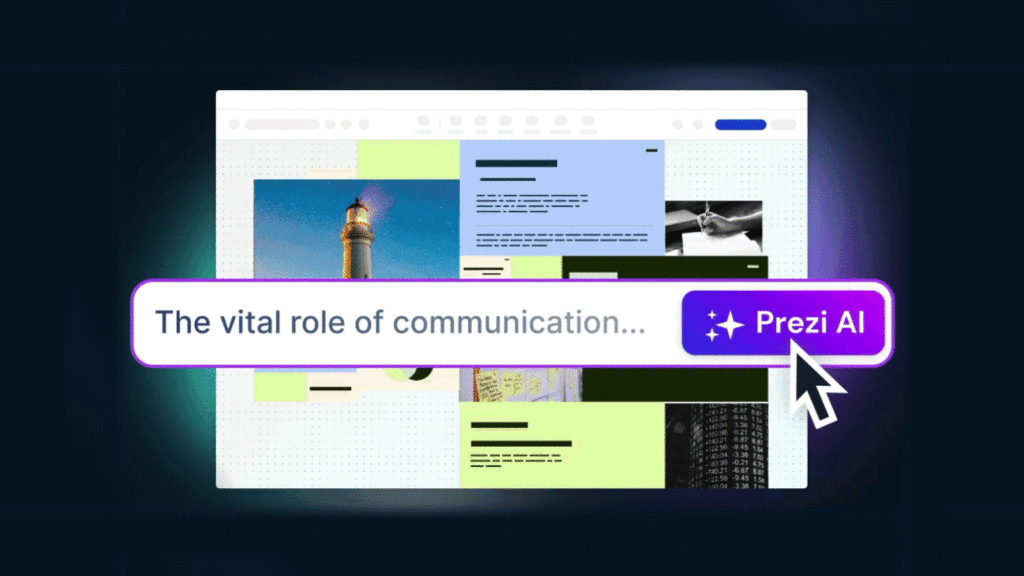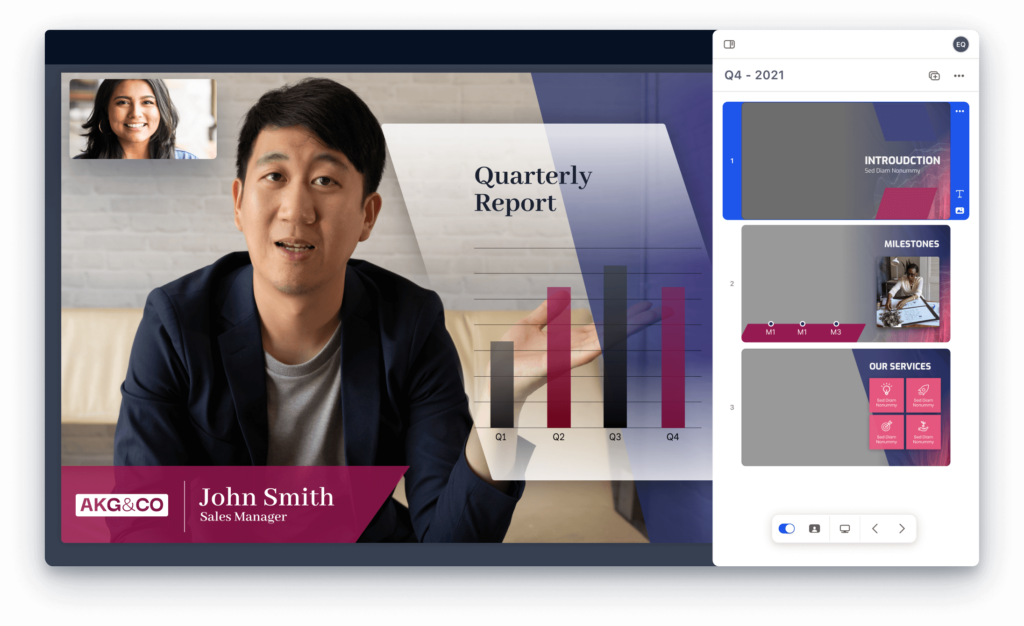So, what is internal communication? It’s an essential part of any successful organization. It’s about the way a company shares information and builds relations. It ensures everyone is moving in the same direction while achieving business goals. High-quality internal communication ensures that staff members remain knowledgeable and are involved in the company’s progress.
There are many ways to share information within a company, such as emails, newsletters, presentations, and collaboration tools. Prezi offers several options for successful internal communication, and, in this article, we’re here to show you how to make the most of them.

The role of internal communication in business success
Internal communication plays a critical role in business success. Explore the following key areas that are impacted the most.
Enhancing employee engagement
Engagement is critical. When employees are kept in the loop and feel involved, their motivation and dedication to their work often increase.
Improving productivity
Clear communication is essential because it can decrease misinterpretations and mistakes. When staff members are equipped with the necessary details, they can work in a more organized way, resulting in increased output.
Boosting morale
When employees feel valued and heard, their morale improves. Consistent communication and feedback can significantly change how employees view their roles and the company. Ultimately, good internal communication creates a positive work environment for all.
Facilitating change management
In any organization, change is inevitable. Whether it’s new policies, technologies, or strategies, effective communication plays a critical role in managing these transitions well. It helps to keep resistance and confusion low while ensuring that every member is included in the decision-making process.
Building trust
Building trust is essential for a healthy work environment. Clear and consistent communication helps create trust between employees and leaders.
Strengthening team collaboration
When executed properly, internal communication has the power to significantly improve teamwork through integration. If every team member stays informed, there are fewer misunderstandings. Open and regular sharing of information fosters cooperation in problem-solving tasks, ultimately leading to more advanced and innovative solutions that can bring the team closer together.

Improving employee retention
When staff members feel appreciated and are actively involved through receiving regular information, they’re more likely to remain committed to the organization. Additionally, good internal communication can help identify issues at an early stage and map out clear career paths for employees, making them feel integral to the company.
Supporting organizational culture
Good internal communication helps to articulate the company’s values, mission, and goals, making them a part of everyday operations. Regularly sharing success stories, recognizing employee achievements, and discussing company milestones can strengthen the cultural fabric of the organization.
These aspects clearly demonstrate how important internal communication is for any business’s success, and that effective internal communication lays the foundation for a thriving workplace.
The role of leadership in internal communication
Effective internal communication starts with leadership. Leaders set the tone and culture for how information is shared within an organization. When leaders prioritize clear and open communication, it encourages a culture where information flows smoothly and effectively throughout the company.
Leading by example
Communicating expectations is one thing, but effectively modeling the desired behavior is another. With that in mind, leaders need to model the communication behaviors they expect from their employees. This means being transparent, approachable, and consistent in their messaging. Open communication about company goals, challenges, and successes helps build trust and encourages similar behavior across all levels of the organization.
Encouraging open dialogue
Building on the previous point, a healthy organizational culture thrives on open communication. However, this openness doesn’t extend to every detail or unfiltered language. Instead, the focus should be on transparency and sharing key information freely. This can be promoted by leaders through regular one-on-one meetings, anonymous suggestion boxes, and open-door policies. When employees are sure their views are appreciated, it promotes a culture of mutual respect and collaboration.

Providing clarity and direction
One of the primary duties of a leader when it comes to internal communication is to give clear directions and purposes. Communicating vividly and distinctly what the company’s vision, goals, and expectations are helps employees see the big picture and their part in it, which can drive motivation – ensuring that employee objectives are aligned with those of the organization.
Recognizing and celebrating success
The use of internal communication for acknowledging and celebrating the achievements of employees is a great way to heighten spirits and positive behavior. It sets an example for others by appreciating individual and team accomplishments on a regular basis. This will go a long way in fostering a culture of recognition and appreciation within the organization.
Leveraging communication tools like Prezi
To reach all employees effectively, leaders must be adept at using various communication tools. This can include using platforms like Prezi for creating and sharing engaging presentations, using video conferencing tools for virtual meetings, and making sure that important messages are accessible on mobile devices. By using a range of tools, managers can ensure their communication is inclusive and reaches every corner of the organization.

Best practices for effective internal communication
To ensure your internal communications have maximum effect, we’ve put together some key tips for you to explore. Let’s dive in!
Develop a comprehensive communication plan
The core of good internal communication is a strong communication plan. First, establish specific goals: what do you want to accomplish through your internal communication? Then, identify your audience segments. Different departments within the organization may need tailored messages and communication channels.
Outline the primary information that aligns with your company’s interests and then choose the most efficient channels for communication. Continuously review and update this plan to ensure it remains relevant as you experience changes in your business or organization. This approach will keep your communication efforts focused and make them more result-oriented.
Use a variety of channels
Communication is not a ‘one size fits all’ concept. Different employees have different preferences for getting information. While some might find emails easy, others might like instant messaging apps or physical meetings. That’s why it’s important to use multiple channels— like newsletters, video conferences, presentations, and collaboration platforms— so that your message can reach everyone in the way they prefer. This not only improves the chance of effective internal communication but also accommodates different working styles and schedules.

Foster two-way communication
Effective internal communication is about more than just passing information along; it’s also about fostering an environment where employees feel comfortable sharing their thoughts and opinions. You can do this by using surveys to gather feedback, setting up anonymous suggestion boxes for confidential input, and holding regular meetings to discuss concerns and ideas openly.
When employees see that their voices are heard and taken into account in decision-making, they feel more valued and engaged. This two-way communication not only boosts morale but also provides leadership with crucial insights into what the workforce is thinking and what they need, helping to shape better strategies for the future.
Keep messages clear and concise
Effective communication is built on clarity. Jargon and complex language have no place as they only serve to confuse your audience. Instead, be sure to deliver your message directly and to the point. When handling complex information, consider using visual aids such as infographics, presentations, or videos. They help in breaking down the information into smaller, more digestible parts.
In addition, visuals can highlight important points that you want to get across— making your communication more interesting and memorable. Always remember — simplicity and accuracy are key in ensuring your messages are understood.
Always measure and improve
An evolving communication is an effective communication. Continually assess your feedback by collecting employee engagement data—such as the number of people who replied to an email and the number of people who read it—and the feedback itself. Use measures like participation rates in surveys, meeting attendance, and the general tone and sentiment from feedback to evaluate the effectiveness of your strategies in driving internal communication. Scrutinize this information for areas that can be improved based on understanding, and act on them by making the necessary changes. This approach guarantees constant evolution towards better strategies for internal communication.
By adopting these best practices, you can construct a solid core of internal communication that keeps employees updated and involved, leading to business success.
Discover more useful techniques in our blog article on internal communication best practices and tips.
Common mistakes that can sabotage internal communication
Even with the best intentions, communication internally can sometimes miss the mark. Here are some common mistakes to avoid to ensure your strategy is effective:
Lack of clarity
An error that can be made in internal communication is a lack of clarity. Jargon, complex language, or vague messages can easily lead to confusion among employees— which in turn paves the way for misunderstandings. Always strive for easy and straightforward communication by simplifying the ideas into terms that everyone can easily understand.
One-way communication
Another frequent mistake is one-way communication— when messages flow from top to bottom without promoting feedback. Effective communication should be a two-way street. Encourage the workforce to communicate their thoughts, feedback, and suggestions through various channels such as surveys and periodic meetings.

Inconsistent messaging
Inconsistent messaging can also sabotage internal communication. When different leaders communicate conflicting information, it creates confusion and distrust. Ensure consistency by aligning all communication with the company’s values, goals, and current initiatives, and regularly updating your leadership team.
Overloading employees with information
Bombarding employees with too much information at once or sending frequent, lengthy communications can overwhelm them. Prioritize and space out your messages, using concise updates and visual aids to highlight the most important points.
Ignoring feedback
Ignoring employee feedback is a critical mistake. It can lead to disengagement and a lack of trust. Show that you value feedback by acknowledging it and taking appropriate actions, and communicate any changes made based on employee suggestions.
Neglecting non-verbal communication
Relying solely on written communication and ignoring the power of visual and face-to-face interactions can limit engagement. Incorporate a mix of communication methods, including video updates and visual presentations to make your messages more engaging.
Lack of follow-up
Sending out important messages without following up can lead to a lack of understanding and implementation. Always follow up on critical communications with meetings or reminder emails to check on progress and address any questions.

Overlooking cultural differences
Don’t overlook the diverse cultural backgrounds of your employees. Misunderstandings and feelings of alienation can have critical consequences. Communication should be inclusive and sensitive to these differences, with training on cultural competence provided when necessary to ensure respect for all cultures involved.
How Prezi can transform your internal communication
Prezi is an excellent tool for internal communication. Whether you’re planning a team meeting or sharing information through a pre-recorded presentation, Prezi offers many ways to relay information effectively across your team.
Prezi’s open-space canvas
Boring and limiting are two words often used to describe traditional presentations. Prezi’s open-space canvas introduces a new way of creating presentations—conversational and non-linear—making the information much more memorable. The open canvas is especially useful for companies, as it fosters increased engagement without requiring a lot of effort from the creator. It enables easy navigation through topics discussed during meetings and allows for detailed discussion points from different perspectives.
This approach ensures employees remain attentive and retain more information. Moreover, it simplifies sharing presentations through entire organizations, keeping everyone informed and up-to-date, which is crucial for those working remotely or as part of hybrid teams.
Prezi AI
Creating visual aids for internal communication often consumes a lot of time, as attention to detail is essential for them to be both informative and visually appealing. Prezi AI simplifies this process, reducing it to just a few clicks, and enabling you to produce professional presentation designs quickly and easily. This tool is especially useful for preparing internal reports, training materials, and company updates, ensuring that your content is engaging yet straightforward.

With Prezi AI, creating presentations is easier than ever. You don’t have to worry about the difficulty of design because it offers smart templates and user-friendly tools that let you focus on your content. This ensures your presentations look professional and high-quality with minimum effort.
Prezi Video
Virtual meetings can be challenging, especially in remote and hybrid work environments, where keeping participants engaged is often difficult. Prezi Video transforms the experience by allowing you to appear alongside your content, creating a more dynamic and interactive presentation. This feature ensures that the audience remains focused, as it feels more like a conversation rather than a traditional, one-dimensional presentation.

By integrating your presence with your visual materials, Prezi Video improves understanding and retention of information, making your meetings more productive and impactful. Additionally, this tool supports various multimedia elements, adding further depth to your presentations and keeping viewers actively involved throughout the session. For more valuable information, read our article on how to boost engagement with internal communication videos.
Plus, Prezi makes it easy to share these visual materials across your organization, so everyone gets consistent and clear information. This improves the effectiveness of your internal communications, keeping all employees well-informed and up-to-date with the company’s progress.
What Prezi can do:
- Customizable templates: Choose from a variety of professionally designed templates.
- User-friendly tools: Enjoy easy-to-use features that simplify the creation process.
- High-quality presentations: Ensure your presentations look polished and professional.
- Easy sharing: Effortlessly distribute visual materials across your organization.
- Maintain brand identity: Maintain clear and uniform messaging for all staff by integrating branding elements into the visuals.
With Prezi, you can transform your internal communication, making it more efficient and effective.
Why presentations are key for good internal communication
Presentations are a standout method for internal communications because they offer a visually engaging way to share information, making it easier for employees to understand and remember key points. Unlike lengthy emails or text-heavy documents, presentations break down information into digestible chunks using visuals like charts, graphs, and images. This not only captures attention but also aids in better understanding.
Prezi Video elevates this experience by allowing presenters to appear alongside their content, adding a personal touch that other methods lack. This makes the communication feel more direct and engaging, especially important in remote and hybrid work environments where maintaining connection and focus can be challenging.
Furthermore, unlike static slides, Prezi’s interactive format allows for a more dynamic presentation, helping to keep the audience engaged from start to finish. By combining visual appeal with the presenter’s presence, Prezi Video ensures that messages are delivered more effectively, making it an ideal tool for internal communications in any company.
Internal communication presentation examples
Experience how interactive and engaging Prezi presentations are and get inspired by the following examples to create your own!
Effective onboarding for PM’s
This is a great presentation example to use in internal communication because it provides a clear, structured, and interesting approach to onboarding. It highlights the importance of the onboarding phase, breaks down complex information into manageable sections (Product, Process, People), and offers specific, actionable steps. The interactive and visual format ensures that new PMs can easily understand and retain crucial information, fostering better engagement and alignment with company goals.
Parental leave policies in financial services
This Prezi effectively conveys critical information through a clear, structured narrative. It highlights real-life scenarios and survey data to show the importance and current challenges of parental leave policies. This approach not only informs but also engages the audience by presenting relatable stories and concrete statistics. By zooming in on specific data and sections, it draws attention to the most important elements, keeping the audience focused and making the presentation more interesting to watch.
Stunning talent has no borders
This Prezi on remote work demonstrates how to effectively highlight key benefits, such as increased productivity and environmental impact, using clear data and real-life examples. For your internal communications, draw inspiration from its approach by focusing on the positive impacts of your message, supported by relevant statistics. The simple design and consistent layout of the presentation make it easy to absorb the information, emphasizing the importance of a clean and coherent format to enhance understanding and retention.
How to fix your underperforming team before it’s too late
This presentation on fixing underperforming teams offers valuable inspiration for internal communications by emphasizing storytelling and clear, actionable steps for improvement. The simple design and consistent layout make the information easy to absorb and follow. Additionally, the use of relatable scenarios, like Joey’s story, and concrete strategies for leadership, such as setting standards and fostering accountability, ensure that the audience remains engaged and retains the key messages.
Do all employees need to have equal benefit plans?
This Prezi on employee benefits serves as an excellent source of inspiration due to its clear, structured layout and use of data visualization to convey complex information. It simplifies intricate topics like self-insured arrangements and IRS nondiscrimination tests, making them accessible and easy-to-understand. This style of presentation is particularly useful for HR departments, financial services firms, or any organization needing to explain detailed policy information to employees or stakeholders.
Boost your internal communications with Prezi
We hope this article has helped clarify the internal communication meaning as well as its importance. Remember, the method you choose to communicate is crucial.

Creating interactive meetings with tools like Prezi can truly maximize your internal communication efforts. By making your presentations more engaging and interactive, you ensure that your employees stay informed, engaged, and aligned with your company’s goals.
Don’t settle for generic methods when you can elevate your communication further. Boost your internal communications with Prezi and witness the positive impact on your organization’s productivity and morale. Start enriching your communication strategy today!
